Aboriginal Health: Addressing Challenges
VerifiedAdded on 2020/04/15
|12
|3101
|53
AI Summary
This assignment delves into the complex health issues confronting Aboriginal and Torres Strait Islander populations in Australia. Students are tasked with analyzing factors contributing to disparities in their well-being, including mental health concerns, the impact of racism within healthcare settings, and the challenges posed by communication barriers between practitioners and patients. The assignment encourages critical thinking about solutions and policies aimed at improving health outcomes for this vulnerable community.
Contribute Materials
Your contribution can guide someone’s learning journey. Share your
documents today.
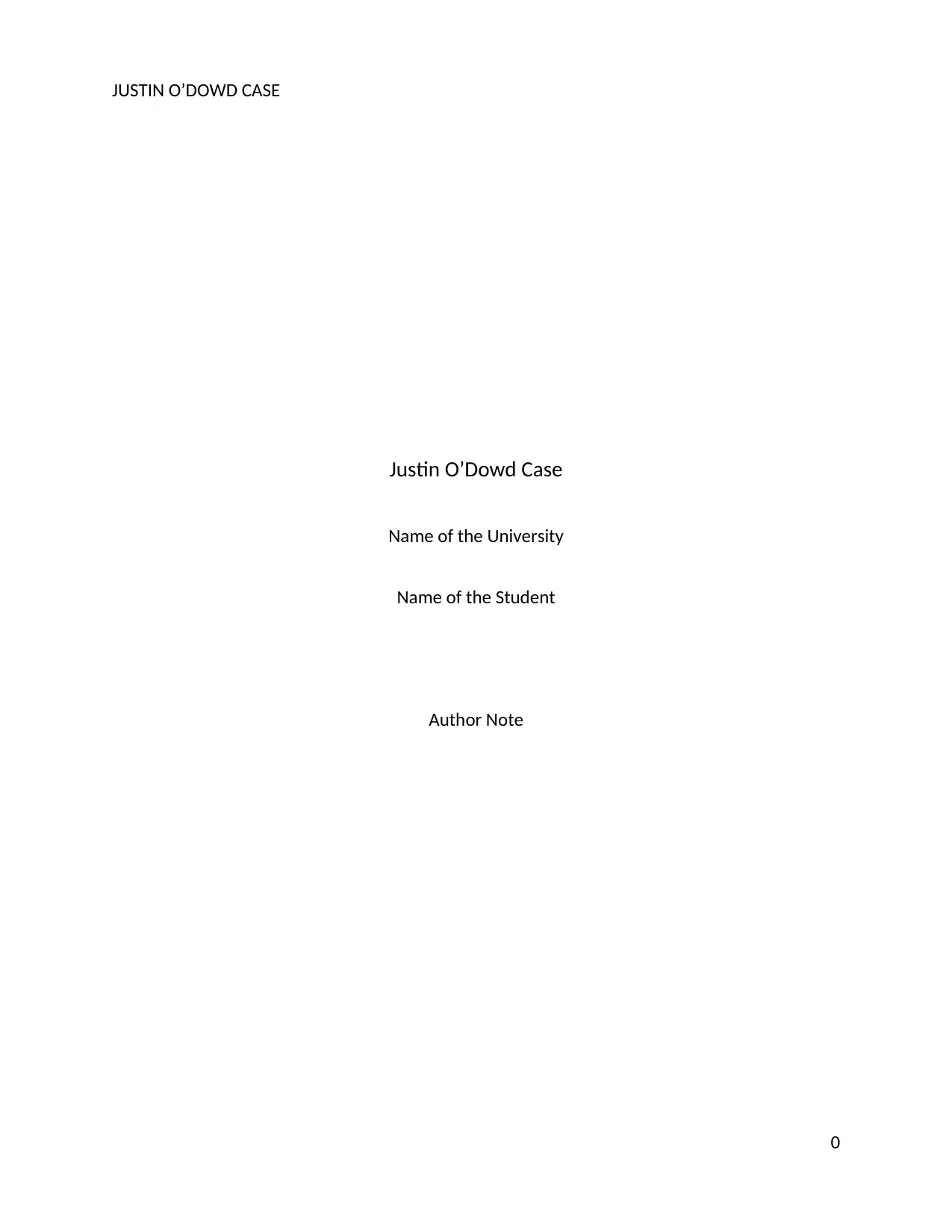
JUSTIN O’DOWD CASE
Justin O’Dowd Case
Name of the University
Name of the Student
Author Note
0
Justin O’Dowd Case
Name of the University
Name of the Student
Author Note
0
Secure Best Marks with AI Grader
Need help grading? Try our AI Grader for instant feedback on your assignments.
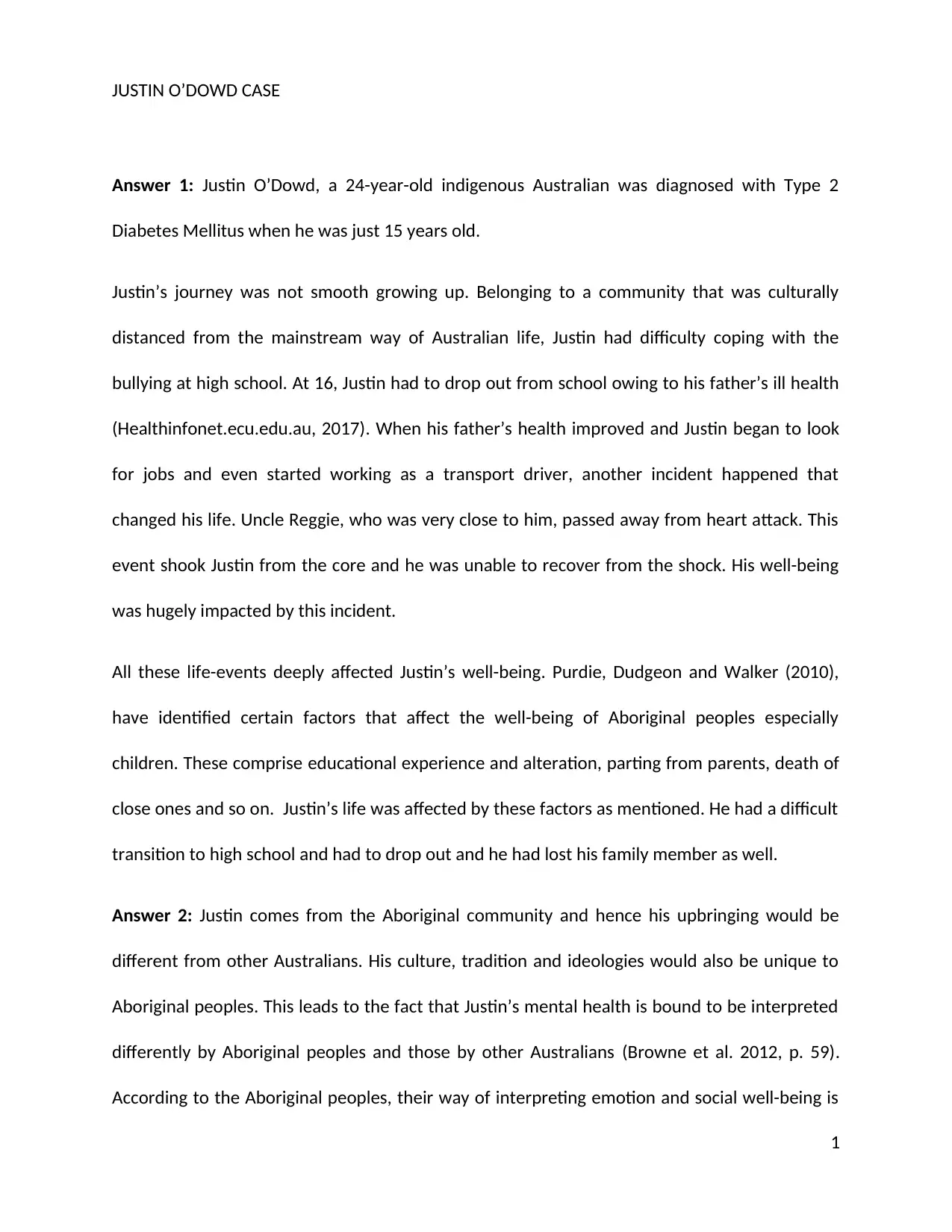
JUSTIN O’DOWD CASE
Answer 1: Justin O’Dowd, a 24-year-old indigenous Australian was diagnosed with Type 2
Diabetes Mellitus when he was just 15 years old.
Justin’s journey was not smooth growing up. Belonging to a community that was culturally
distanced from the mainstream way of Australian life, Justin had difficulty coping with the
bullying at high school. At 16, Justin had to drop out from school owing to his father’s ill health
(Healthinfonet.ecu.edu.au, 2017). When his father’s health improved and Justin began to look
for jobs and even started working as a transport driver, another incident happened that
changed his life. Uncle Reggie, who was very close to him, passed away from heart attack. This
event shook Justin from the core and he was unable to recover from the shock. His well-being
was hugely impacted by this incident.
All these life-events deeply affected Justin’s well-being. Purdie, Dudgeon and Walker (2010),
have identified certain factors that affect the well-being of Aboriginal peoples especially
children. These comprise educational experience and alteration, parting from parents, death of
close ones and so on. Justin’s life was affected by these factors as mentioned. He had a difficult
transition to high school and had to drop out and he had lost his family member as well.
Answer 2: Justin comes from the Aboriginal community and hence his upbringing would be
different from other Australians. His culture, tradition and ideologies would also be unique to
Aboriginal peoples. This leads to the fact that Justin’s mental health is bound to be interpreted
differently by Aboriginal peoples and those by other Australians (Browne et al. 2012, p. 59).
According to the Aboriginal peoples, their way of interpreting emotion and social well-being is
1
Answer 1: Justin O’Dowd, a 24-year-old indigenous Australian was diagnosed with Type 2
Diabetes Mellitus when he was just 15 years old.
Justin’s journey was not smooth growing up. Belonging to a community that was culturally
distanced from the mainstream way of Australian life, Justin had difficulty coping with the
bullying at high school. At 16, Justin had to drop out from school owing to his father’s ill health
(Healthinfonet.ecu.edu.au, 2017). When his father’s health improved and Justin began to look
for jobs and even started working as a transport driver, another incident happened that
changed his life. Uncle Reggie, who was very close to him, passed away from heart attack. This
event shook Justin from the core and he was unable to recover from the shock. His well-being
was hugely impacted by this incident.
All these life-events deeply affected Justin’s well-being. Purdie, Dudgeon and Walker (2010),
have identified certain factors that affect the well-being of Aboriginal peoples especially
children. These comprise educational experience and alteration, parting from parents, death of
close ones and so on. Justin’s life was affected by these factors as mentioned. He had a difficult
transition to high school and had to drop out and he had lost his family member as well.
Answer 2: Justin comes from the Aboriginal community and hence his upbringing would be
different from other Australians. His culture, tradition and ideologies would also be unique to
Aboriginal peoples. This leads to the fact that Justin’s mental health is bound to be interpreted
differently by Aboriginal peoples and those by other Australians (Browne et al. 2012, p. 59).
According to the Aboriginal peoples, their way of interpreting emotion and social well-being is
1
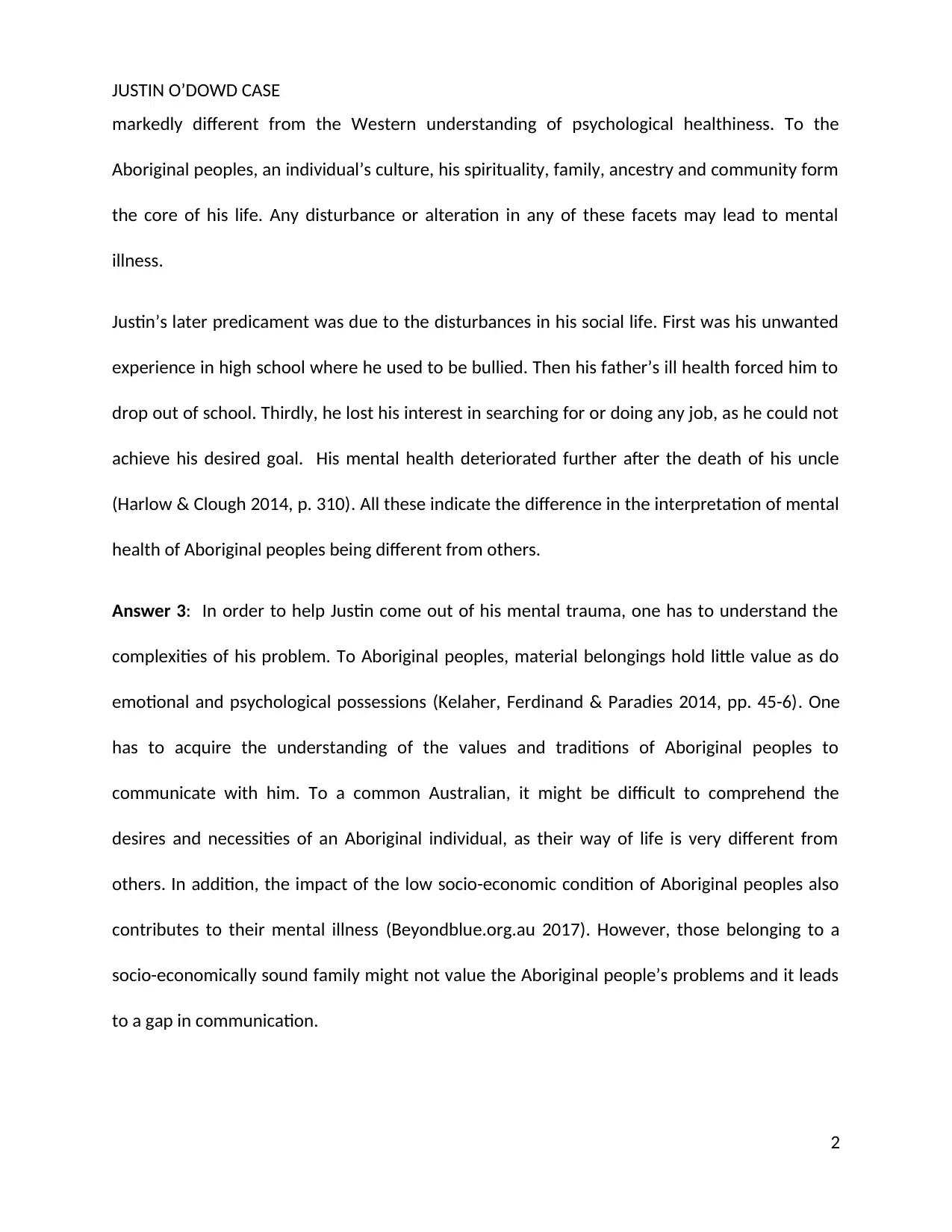
JUSTIN O’DOWD CASE
markedly different from the Western understanding of psychological healthiness. To the
Aboriginal peoples, an individual’s culture, his spirituality, family, ancestry and community form
the core of his life. Any disturbance or alteration in any of these facets may lead to mental
illness.
Justin’s later predicament was due to the disturbances in his social life. First was his unwanted
experience in high school where he used to be bullied. Then his father’s ill health forced him to
drop out of school. Thirdly, he lost his interest in searching for or doing any job, as he could not
achieve his desired goal. His mental health deteriorated further after the death of his uncle
(Harlow & Clough 2014, p. 310). All these indicate the difference in the interpretation of mental
health of Aboriginal peoples being different from others.
Answer 3: In order to help Justin come out of his mental trauma, one has to understand the
complexities of his problem. To Aboriginal peoples, material belongings hold little value as do
emotional and psychological possessions (Kelaher, Ferdinand & Paradies 2014, pp. 45-6). One
has to acquire the understanding of the values and traditions of Aboriginal peoples to
communicate with him. To a common Australian, it might be difficult to comprehend the
desires and necessities of an Aboriginal individual, as their way of life is very different from
others. In addition, the impact of the low socio-economic condition of Aboriginal peoples also
contributes to their mental illness (Beyondblue.org.au 2017). However, those belonging to a
socio-economically sound family might not value the Aboriginal people’s problems and it leads
to a gap in communication.
2
markedly different from the Western understanding of psychological healthiness. To the
Aboriginal peoples, an individual’s culture, his spirituality, family, ancestry and community form
the core of his life. Any disturbance or alteration in any of these facets may lead to mental
illness.
Justin’s later predicament was due to the disturbances in his social life. First was his unwanted
experience in high school where he used to be bullied. Then his father’s ill health forced him to
drop out of school. Thirdly, he lost his interest in searching for or doing any job, as he could not
achieve his desired goal. His mental health deteriorated further after the death of his uncle
(Harlow & Clough 2014, p. 310). All these indicate the difference in the interpretation of mental
health of Aboriginal peoples being different from others.
Answer 3: In order to help Justin come out of his mental trauma, one has to understand the
complexities of his problem. To Aboriginal peoples, material belongings hold little value as do
emotional and psychological possessions (Kelaher, Ferdinand & Paradies 2014, pp. 45-6). One
has to acquire the understanding of the values and traditions of Aboriginal peoples to
communicate with him. To a common Australian, it might be difficult to comprehend the
desires and necessities of an Aboriginal individual, as their way of life is very different from
others. In addition, the impact of the low socio-economic condition of Aboriginal peoples also
contributes to their mental illness (Beyondblue.org.au 2017). However, those belonging to a
socio-economically sound family might not value the Aboriginal people’s problems and it leads
to a gap in communication.
2
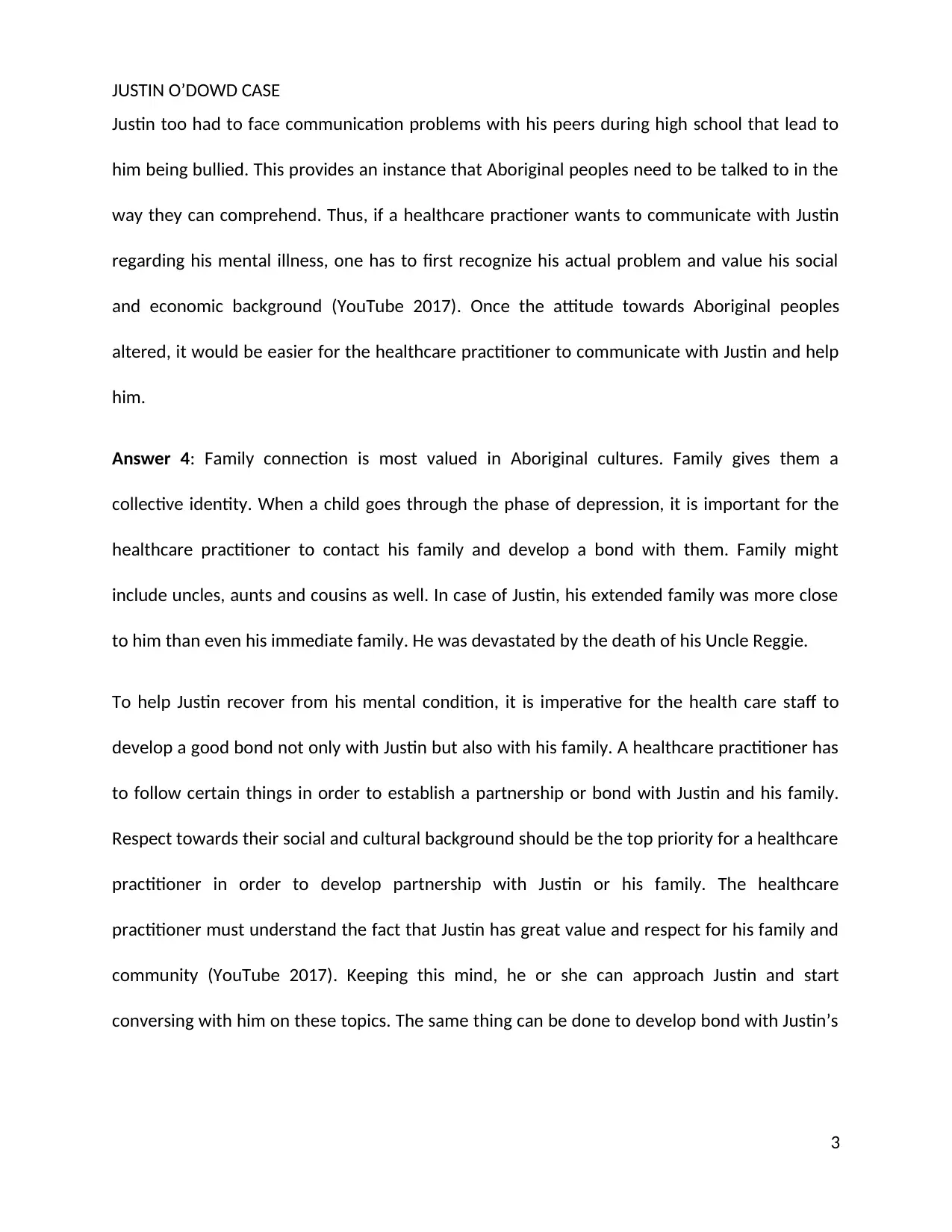
JUSTIN O’DOWD CASE
Justin too had to face communication problems with his peers during high school that lead to
him being bullied. This provides an instance that Aboriginal peoples need to be talked to in the
way they can comprehend. Thus, if a healthcare practioner wants to communicate with Justin
regarding his mental illness, one has to first recognize his actual problem and value his social
and economic background (YouTube 2017). Once the attitude towards Aboriginal peoples
altered, it would be easier for the healthcare practitioner to communicate with Justin and help
him.
Answer 4: Family connection is most valued in Aboriginal cultures. Family gives them a
collective identity. When a child goes through the phase of depression, it is important for the
healthcare practitioner to contact his family and develop a bond with them. Family might
include uncles, aunts and cousins as well. In case of Justin, his extended family was more close
to him than even his immediate family. He was devastated by the death of his Uncle Reggie.
To help Justin recover from his mental condition, it is imperative for the health care staff to
develop a good bond not only with Justin but also with his family. A healthcare practitioner has
to follow certain things in order to establish a partnership or bond with Justin and his family.
Respect towards their social and cultural background should be the top priority for a healthcare
practitioner in order to develop partnership with Justin or his family. The healthcare
practitioner must understand the fact that Justin has great value and respect for his family and
community (YouTube 2017). Keeping this mind, he or she can approach Justin and start
conversing with him on these topics. The same thing can be done to develop bond with Justin’s
3
Justin too had to face communication problems with his peers during high school that lead to
him being bullied. This provides an instance that Aboriginal peoples need to be talked to in the
way they can comprehend. Thus, if a healthcare practioner wants to communicate with Justin
regarding his mental illness, one has to first recognize his actual problem and value his social
and economic background (YouTube 2017). Once the attitude towards Aboriginal peoples
altered, it would be easier for the healthcare practitioner to communicate with Justin and help
him.
Answer 4: Family connection is most valued in Aboriginal cultures. Family gives them a
collective identity. When a child goes through the phase of depression, it is important for the
healthcare practitioner to contact his family and develop a bond with them. Family might
include uncles, aunts and cousins as well. In case of Justin, his extended family was more close
to him than even his immediate family. He was devastated by the death of his Uncle Reggie.
To help Justin recover from his mental condition, it is imperative for the health care staff to
develop a good bond not only with Justin but also with his family. A healthcare practitioner has
to follow certain things in order to establish a partnership or bond with Justin and his family.
Respect towards their social and cultural background should be the top priority for a healthcare
practitioner in order to develop partnership with Justin or his family. The healthcare
practitioner must understand the fact that Justin has great value and respect for his family and
community (YouTube 2017). Keeping this mind, he or she can approach Justin and start
conversing with him on these topics. The same thing can be done to develop bond with Justin’s
3
Secure Best Marks with AI Grader
Need help grading? Try our AI Grader for instant feedback on your assignments.
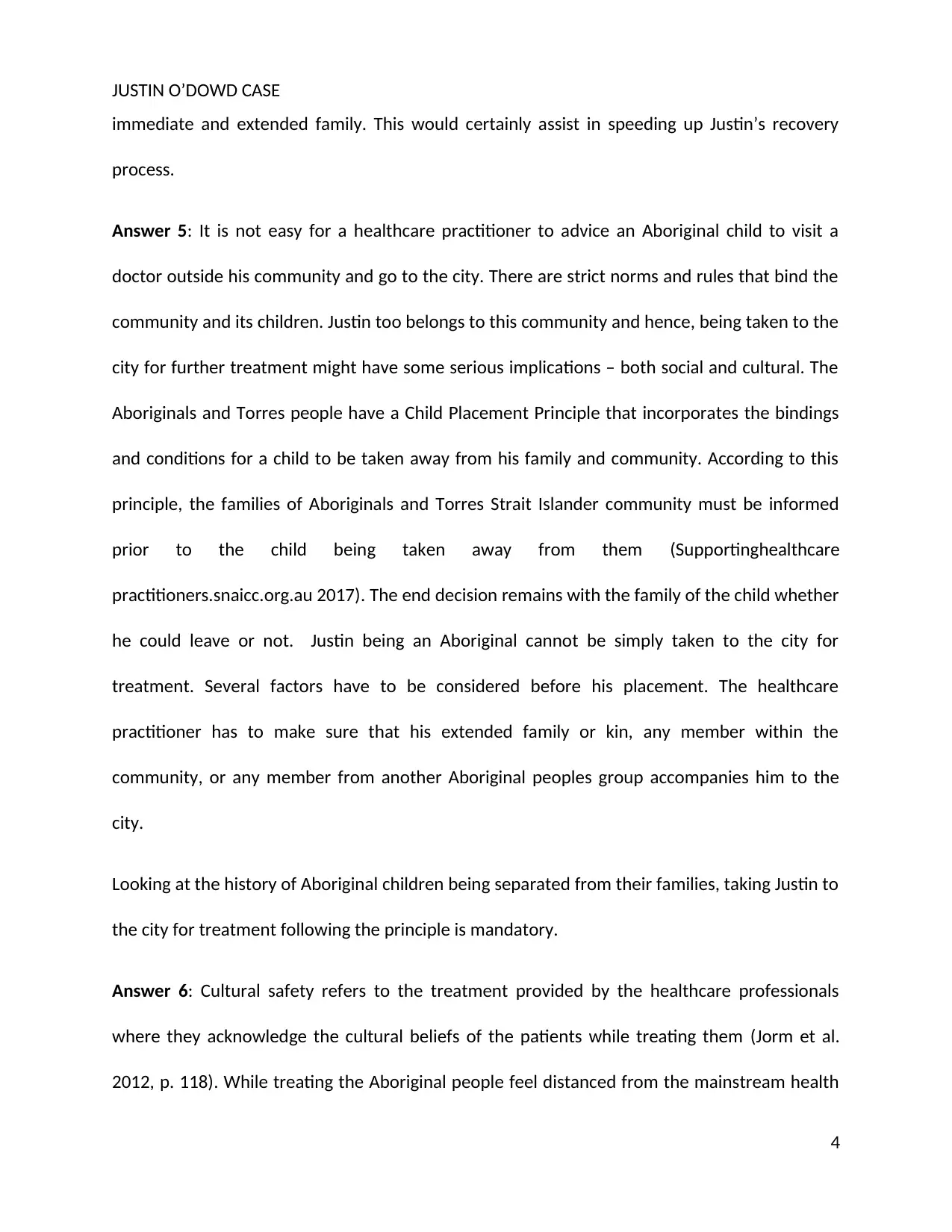
JUSTIN O’DOWD CASE
immediate and extended family. This would certainly assist in speeding up Justin’s recovery
process.
Answer 5: It is not easy for a healthcare practitioner to advice an Aboriginal child to visit a
doctor outside his community and go to the city. There are strict norms and rules that bind the
community and its children. Justin too belongs to this community and hence, being taken to the
city for further treatment might have some serious implications – both social and cultural. The
Aboriginals and Torres people have a Child Placement Principle that incorporates the bindings
and conditions for a child to be taken away from his family and community. According to this
principle, the families of Aboriginals and Torres Strait Islander community must be informed
prior to the child being taken away from them (Supportinghealthcare
practitioners.snaicc.org.au 2017). The end decision remains with the family of the child whether
he could leave or not. Justin being an Aboriginal cannot be simply taken to the city for
treatment. Several factors have to be considered before his placement. The healthcare
practitioner has to make sure that his extended family or kin, any member within the
community, or any member from another Aboriginal peoples group accompanies him to the
city.
Looking at the history of Aboriginal children being separated from their families, taking Justin to
the city for treatment following the principle is mandatory.
Answer 6: Cultural safety refers to the treatment provided by the healthcare professionals
where they acknowledge the cultural beliefs of the patients while treating them (Jorm et al.
2012, p. 118). While treating the Aboriginal people feel distanced from the mainstream health
4
immediate and extended family. This would certainly assist in speeding up Justin’s recovery
process.
Answer 5: It is not easy for a healthcare practitioner to advice an Aboriginal child to visit a
doctor outside his community and go to the city. There are strict norms and rules that bind the
community and its children. Justin too belongs to this community and hence, being taken to the
city for further treatment might have some serious implications – both social and cultural. The
Aboriginals and Torres people have a Child Placement Principle that incorporates the bindings
and conditions for a child to be taken away from his family and community. According to this
principle, the families of Aboriginals and Torres Strait Islander community must be informed
prior to the child being taken away from them (Supportinghealthcare
practitioners.snaicc.org.au 2017). The end decision remains with the family of the child whether
he could leave or not. Justin being an Aboriginal cannot be simply taken to the city for
treatment. Several factors have to be considered before his placement. The healthcare
practitioner has to make sure that his extended family or kin, any member within the
community, or any member from another Aboriginal peoples group accompanies him to the
city.
Looking at the history of Aboriginal children being separated from their families, taking Justin to
the city for treatment following the principle is mandatory.
Answer 6: Cultural safety refers to the treatment provided by the healthcare professionals
where they acknowledge the cultural beliefs of the patients while treating them (Jorm et al.
2012, p. 118). While treating the Aboriginal people feel distanced from the mainstream health
4
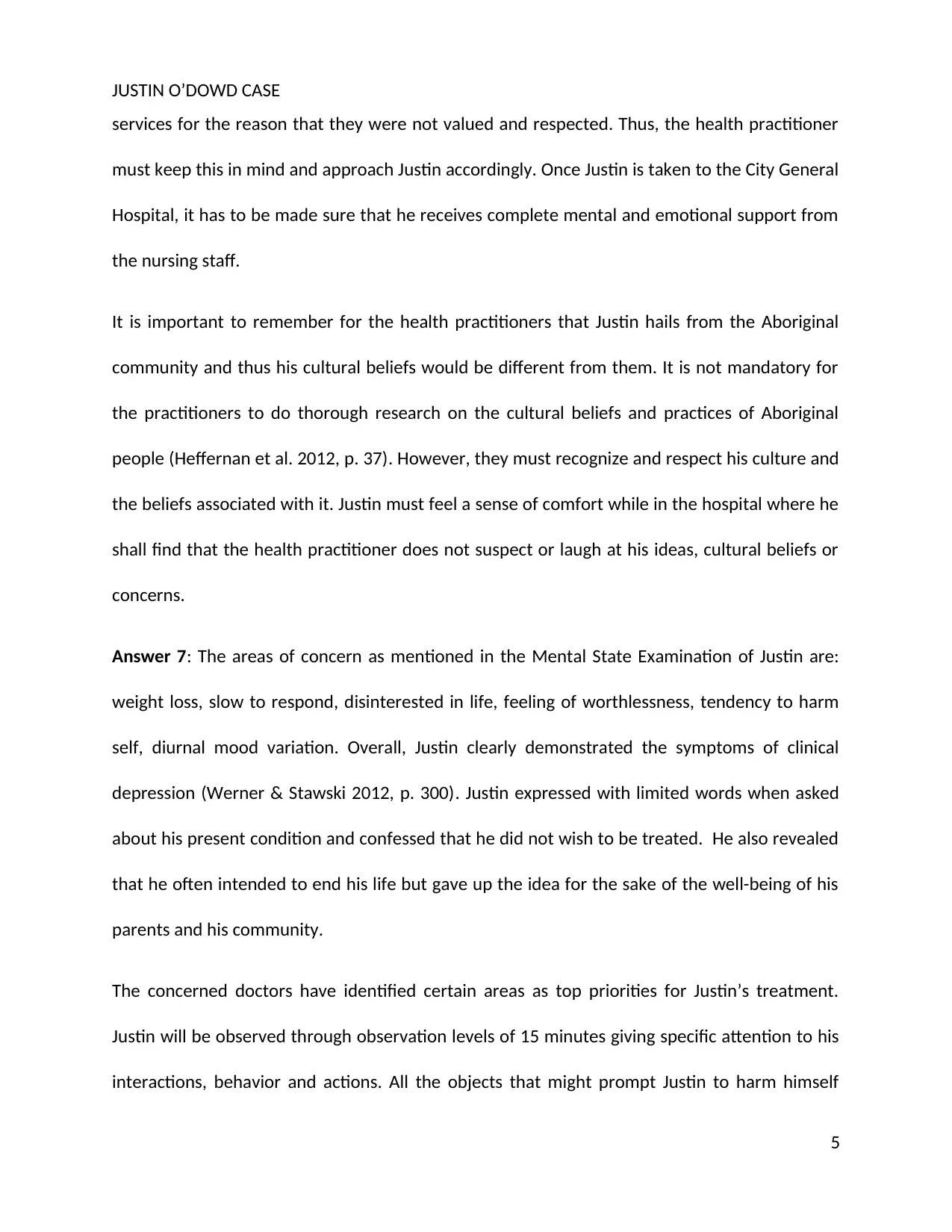
JUSTIN O’DOWD CASE
services for the reason that they were not valued and respected. Thus, the health practitioner
must keep this in mind and approach Justin accordingly. Once Justin is taken to the City General
Hospital, it has to be made sure that he receives complete mental and emotional support from
the nursing staff.
It is important to remember for the health practitioners that Justin hails from the Aboriginal
community and thus his cultural beliefs would be different from them. It is not mandatory for
the practitioners to do thorough research on the cultural beliefs and practices of Aboriginal
people (Heffernan et al. 2012, p. 37). However, they must recognize and respect his culture and
the beliefs associated with it. Justin must feel a sense of comfort while in the hospital where he
shall find that the health practitioner does not suspect or laugh at his ideas, cultural beliefs or
concerns.
Answer 7: The areas of concern as mentioned in the Mental State Examination of Justin are:
weight loss, slow to respond, disinterested in life, feeling of worthlessness, tendency to harm
self, diurnal mood variation. Overall, Justin clearly demonstrated the symptoms of clinical
depression (Werner & Stawski 2012, p. 300). Justin expressed with limited words when asked
about his present condition and confessed that he did not wish to be treated. He also revealed
that he often intended to end his life but gave up the idea for the sake of the well-being of his
parents and his community.
The concerned doctors have identified certain areas as top priorities for Justin’s treatment.
Justin will be observed through observation levels of 15 minutes giving specific attention to his
interactions, behavior and actions. All the objects that might prompt Justin to harm himself
5
services for the reason that they were not valued and respected. Thus, the health practitioner
must keep this in mind and approach Justin accordingly. Once Justin is taken to the City General
Hospital, it has to be made sure that he receives complete mental and emotional support from
the nursing staff.
It is important to remember for the health practitioners that Justin hails from the Aboriginal
community and thus his cultural beliefs would be different from them. It is not mandatory for
the practitioners to do thorough research on the cultural beliefs and practices of Aboriginal
people (Heffernan et al. 2012, p. 37). However, they must recognize and respect his culture and
the beliefs associated with it. Justin must feel a sense of comfort while in the hospital where he
shall find that the health practitioner does not suspect or laugh at his ideas, cultural beliefs or
concerns.
Answer 7: The areas of concern as mentioned in the Mental State Examination of Justin are:
weight loss, slow to respond, disinterested in life, feeling of worthlessness, tendency to harm
self, diurnal mood variation. Overall, Justin clearly demonstrated the symptoms of clinical
depression (Werner & Stawski 2012, p. 300). Justin expressed with limited words when asked
about his present condition and confessed that he did not wish to be treated. He also revealed
that he often intended to end his life but gave up the idea for the sake of the well-being of his
parents and his community.
The concerned doctors have identified certain areas as top priorities for Justin’s treatment.
Justin will be observed through observation levels of 15 minutes giving specific attention to his
interactions, behavior and actions. All the objects that might prompt Justin to harm himself
5

JUSTIN O’DOWD CASE
shall be removed from his reach (Hunter 2014). Continuous care to be provided to Justin by
establishing a therapeutic relationship. He will also be given the opportunity and the
environment to identify his weaknesses and strengths. The staff will encourage Justin to
establish supportive relationships beyond the confinements of the hospital. Prescribed
medication shall also be administered.
Answer 8: In order to communicate with a patient suffering from clinical depression, a health
professional must be extremely careful not to be loud or authoritative (Doyle 2012, p. 50).
Establishing a rapport while interacting, using the appropriate language and gesture,
maintaining correct eye contact are amongst some of the basic skills required for a health
professional to communicate with Aboriginal people going through depression
(Health.qld.gov.au 2017). The healthcare professional must demonstrate a cultural
understanding of the Aboriginal people.
John Brody, the health professional, made sure to meet and greet Justin in a friendly and warm
manner. He encouraged Justin to share his feelings in the beginning and be open about it. The
health professional managed to form an environment where Justin could freely share his
thoughts, beliefs, and concerns about his present predicament (Swain & Gale 2014, p. 1242).
He ensured avoiding jargons and complicated sentences that might confuse Justin.
It is bounding on a health professional to approach a patient with clinical depression in a
friendly manner and establish a bond with the individual (YouTube 2017).
Answer 9: Justin was admitted to the City Hospital in April of 2014 on grounds of clinical
depression and suicidal ideation. After three months, Justin showed signs of marked
6
shall be removed from his reach (Hunter 2014). Continuous care to be provided to Justin by
establishing a therapeutic relationship. He will also be given the opportunity and the
environment to identify his weaknesses and strengths. The staff will encourage Justin to
establish supportive relationships beyond the confinements of the hospital. Prescribed
medication shall also be administered.
Answer 8: In order to communicate with a patient suffering from clinical depression, a health
professional must be extremely careful not to be loud or authoritative (Doyle 2012, p. 50).
Establishing a rapport while interacting, using the appropriate language and gesture,
maintaining correct eye contact are amongst some of the basic skills required for a health
professional to communicate with Aboriginal people going through depression
(Health.qld.gov.au 2017). The healthcare professional must demonstrate a cultural
understanding of the Aboriginal people.
John Brody, the health professional, made sure to meet and greet Justin in a friendly and warm
manner. He encouraged Justin to share his feelings in the beginning and be open about it. The
health professional managed to form an environment where Justin could freely share his
thoughts, beliefs, and concerns about his present predicament (Swain & Gale 2014, p. 1242).
He ensured avoiding jargons and complicated sentences that might confuse Justin.
It is bounding on a health professional to approach a patient with clinical depression in a
friendly manner and establish a bond with the individual (YouTube 2017).
Answer 9: Justin was admitted to the City Hospital in April of 2014 on grounds of clinical
depression and suicidal ideation. After three months, Justin showed signs of marked
6
Paraphrase This Document
Need a fresh take? Get an instant paraphrase of this document with our AI Paraphraser
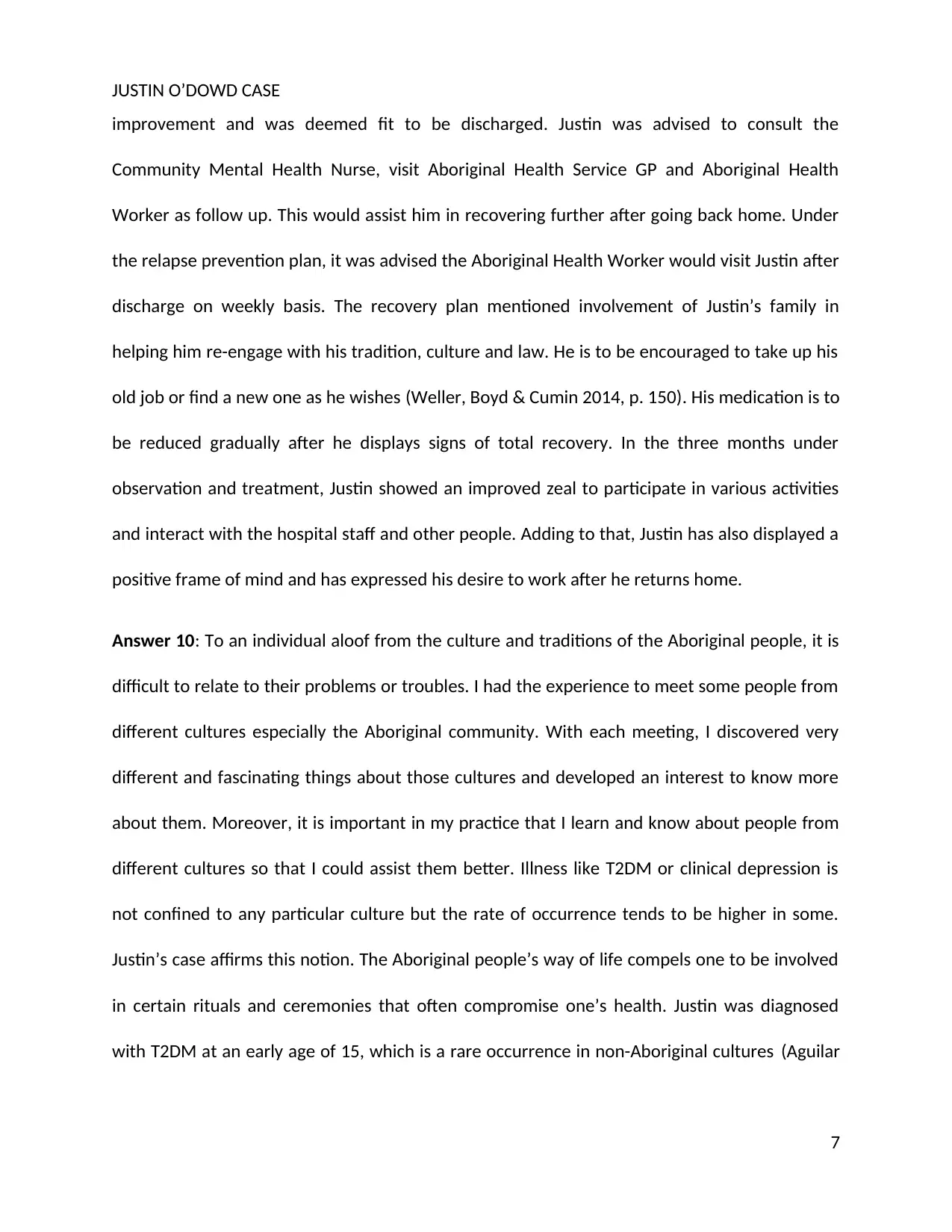
JUSTIN O’DOWD CASE
improvement and was deemed fit to be discharged. Justin was advised to consult the
Community Mental Health Nurse, visit Aboriginal Health Service GP and Aboriginal Health
Worker as follow up. This would assist him in recovering further after going back home. Under
the relapse prevention plan, it was advised the Aboriginal Health Worker would visit Justin after
discharge on weekly basis. The recovery plan mentioned involvement of Justin’s family in
helping him re-engage with his tradition, culture and law. He is to be encouraged to take up his
old job or find a new one as he wishes (Weller, Boyd & Cumin 2014, p. 150). His medication is to
be reduced gradually after he displays signs of total recovery. In the three months under
observation and treatment, Justin showed an improved zeal to participate in various activities
and interact with the hospital staff and other people. Adding to that, Justin has also displayed a
positive frame of mind and has expressed his desire to work after he returns home.
Answer 10: To an individual aloof from the culture and traditions of the Aboriginal people, it is
difficult to relate to their problems or troubles. I had the experience to meet some people from
different cultures especially the Aboriginal community. With each meeting, I discovered very
different and fascinating things about those cultures and developed an interest to know more
about them. Moreover, it is important in my practice that I learn and know about people from
different cultures so that I could assist them better. Illness like T2DM or clinical depression is
not confined to any particular culture but the rate of occurrence tends to be higher in some.
Justin’s case affirms this notion. The Aboriginal people’s way of life compels one to be involved
in certain rituals and ceremonies that often compromise one’s health. Justin was diagnosed
with T2DM at an early age of 15, which is a rare occurrence in non-Aboriginal cultures (Aguilar
7
improvement and was deemed fit to be discharged. Justin was advised to consult the
Community Mental Health Nurse, visit Aboriginal Health Service GP and Aboriginal Health
Worker as follow up. This would assist him in recovering further after going back home. Under
the relapse prevention plan, it was advised the Aboriginal Health Worker would visit Justin after
discharge on weekly basis. The recovery plan mentioned involvement of Justin’s family in
helping him re-engage with his tradition, culture and law. He is to be encouraged to take up his
old job or find a new one as he wishes (Weller, Boyd & Cumin 2014, p. 150). His medication is to
be reduced gradually after he displays signs of total recovery. In the three months under
observation and treatment, Justin showed an improved zeal to participate in various activities
and interact with the hospital staff and other people. Adding to that, Justin has also displayed a
positive frame of mind and has expressed his desire to work after he returns home.
Answer 10: To an individual aloof from the culture and traditions of the Aboriginal people, it is
difficult to relate to their problems or troubles. I had the experience to meet some people from
different cultures especially the Aboriginal community. With each meeting, I discovered very
different and fascinating things about those cultures and developed an interest to know more
about them. Moreover, it is important in my practice that I learn and know about people from
different cultures so that I could assist them better. Illness like T2DM or clinical depression is
not confined to any particular culture but the rate of occurrence tends to be higher in some.
Justin’s case affirms this notion. The Aboriginal people’s way of life compels one to be involved
in certain rituals and ceremonies that often compromise one’s health. Justin was diagnosed
with T2DM at an early age of 15, which is a rare occurrence in non-Aboriginal cultures (Aguilar
7
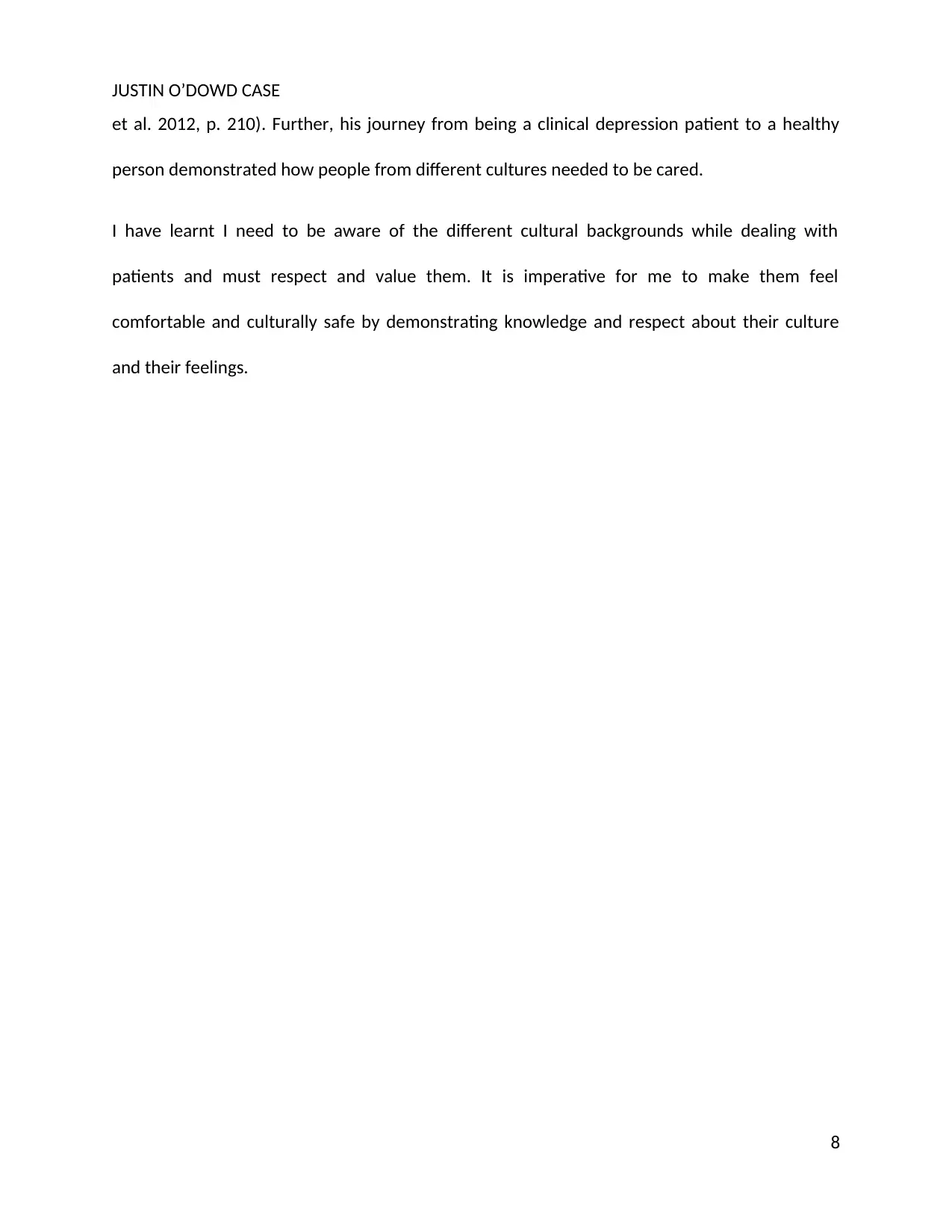
JUSTIN O’DOWD CASE
et al. 2012, p. 210). Further, his journey from being a clinical depression patient to a healthy
person demonstrated how people from different cultures needed to be cared.
I have learnt I need to be aware of the different cultural backgrounds while dealing with
patients and must respect and value them. It is imperative for me to make them feel
comfortable and culturally safe by demonstrating knowledge and respect about their culture
and their feelings.
8
et al. 2012, p. 210). Further, his journey from being a clinical depression patient to a healthy
person demonstrated how people from different cultures needed to be cared.
I have learnt I need to be aware of the different cultural backgrounds while dealing with
patients and must respect and value them. It is imperative for me to make them feel
comfortable and culturally safe by demonstrating knowledge and respect about their culture
and their feelings.
8
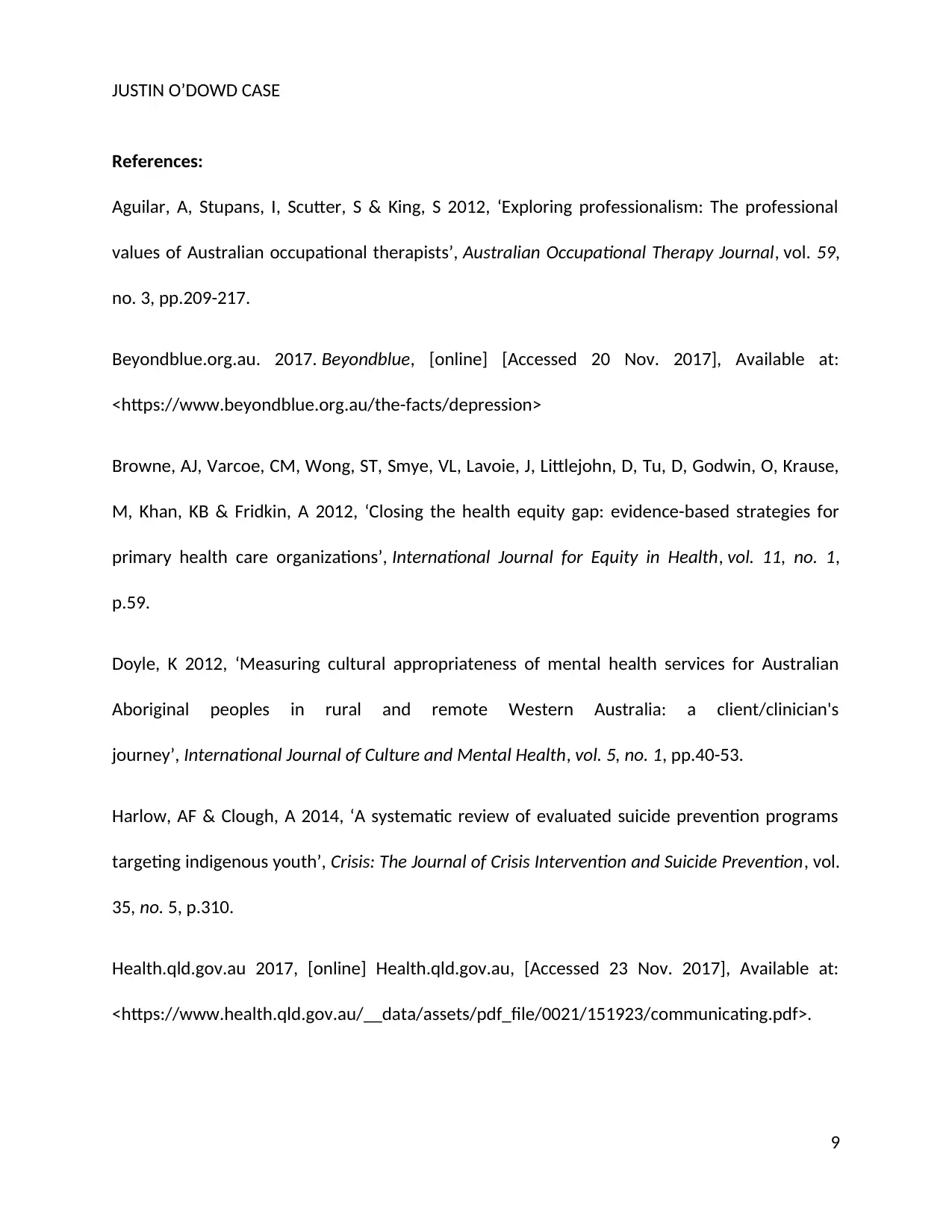
JUSTIN O’DOWD CASE
References:
Aguilar, A, Stupans, I, Scutter, S & King, S 2012, ‘Exploring professionalism: The professional
values of Australian occupational therapists’, Australian Occupational Therapy Journal, vol. 59,
no. 3, pp.209-217.
Beyondblue.org.au. 2017. Beyondblue, [online] [Accessed 20 Nov. 2017], Available at:
<https://www.beyondblue.org.au/the-facts/depression>
Browne, AJ, Varcoe, CM, Wong, ST, Smye, VL, Lavoie, J, Littlejohn, D, Tu, D, Godwin, O, Krause,
M, Khan, KB & Fridkin, A 2012, ‘Closing the health equity gap: evidence-based strategies for
primary health care organizations’, International Journal for Equity in Health, vol. 11, no. 1,
p.59.
Doyle, K 2012, ‘Measuring cultural appropriateness of mental health services for Australian
Aboriginal peoples in rural and remote Western Australia: a client/clinician's
journey’, International Journal of Culture and Mental Health, vol. 5, no. 1, pp.40-53.
Harlow, AF & Clough, A 2014, ‘A systematic review of evaluated suicide prevention programs
targeting indigenous youth’, Crisis: The Journal of Crisis Intervention and Suicide Prevention, vol.
35, no. 5, p.310.
Health.qld.gov.au 2017, [online] Health.qld.gov.au, [Accessed 23 Nov. 2017], Available at:
<https://www.health.qld.gov.au/__data/assets/pdf_file/0021/151923/communicating.pdf>.
9
References:
Aguilar, A, Stupans, I, Scutter, S & King, S 2012, ‘Exploring professionalism: The professional
values of Australian occupational therapists’, Australian Occupational Therapy Journal, vol. 59,
no. 3, pp.209-217.
Beyondblue.org.au. 2017. Beyondblue, [online] [Accessed 20 Nov. 2017], Available at:
<https://www.beyondblue.org.au/the-facts/depression>
Browne, AJ, Varcoe, CM, Wong, ST, Smye, VL, Lavoie, J, Littlejohn, D, Tu, D, Godwin, O, Krause,
M, Khan, KB & Fridkin, A 2012, ‘Closing the health equity gap: evidence-based strategies for
primary health care organizations’, International Journal for Equity in Health, vol. 11, no. 1,
p.59.
Doyle, K 2012, ‘Measuring cultural appropriateness of mental health services for Australian
Aboriginal peoples in rural and remote Western Australia: a client/clinician's
journey’, International Journal of Culture and Mental Health, vol. 5, no. 1, pp.40-53.
Harlow, AF & Clough, A 2014, ‘A systematic review of evaluated suicide prevention programs
targeting indigenous youth’, Crisis: The Journal of Crisis Intervention and Suicide Prevention, vol.
35, no. 5, p.310.
Health.qld.gov.au 2017, [online] Health.qld.gov.au, [Accessed 23 Nov. 2017], Available at:
<https://www.health.qld.gov.au/__data/assets/pdf_file/0021/151923/communicating.pdf>.
9
Secure Best Marks with AI Grader
Need help grading? Try our AI Grader for instant feedback on your assignments.
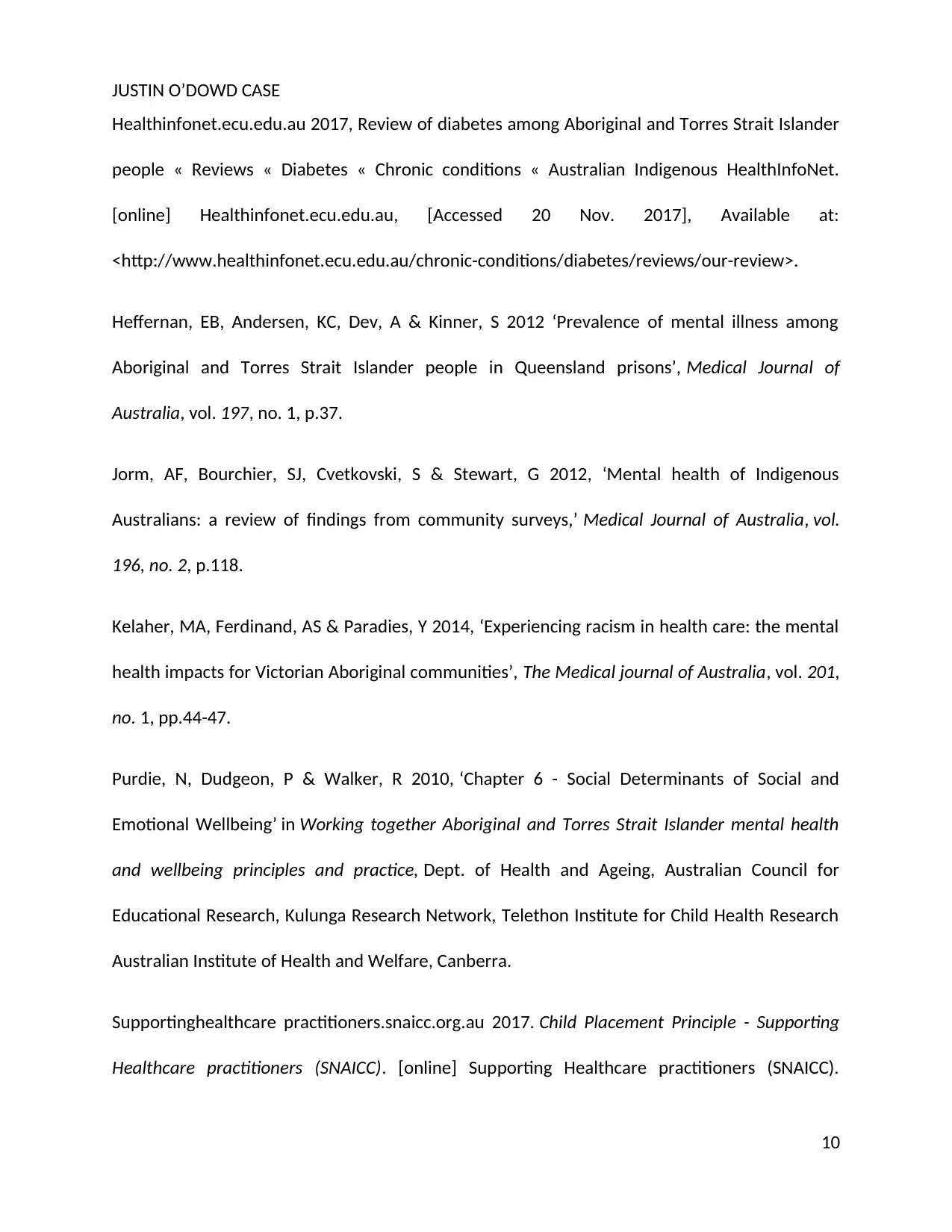
JUSTIN O’DOWD CASE
Healthinfonet.ecu.edu.au 2017, Review of diabetes among Aboriginal and Torres Strait Islander
people « Reviews « Diabetes « Chronic conditions « Australian Indigenous HealthInfoNet.
[online] Healthinfonet.ecu.edu.au, [Accessed 20 Nov. 2017], Available at:
<http://www.healthinfonet.ecu.edu.au/chronic-conditions/diabetes/reviews/our-review>.
Heffernan, EB, Andersen, KC, Dev, A & Kinner, S 2012 ‘Prevalence of mental illness among
Aboriginal and Torres Strait Islander people in Queensland prisons’, Medical Journal of
Australia, vol. 197, no. 1, p.37.
Jorm, AF, Bourchier, SJ, Cvetkovski, S & Stewart, G 2012, ‘Mental health of Indigenous
Australians: a review of findings from community surveys,’ Medical Journal of Australia, vol.
196, no. 2, p.118.
Kelaher, MA, Ferdinand, AS & Paradies, Y 2014, ‘Experiencing racism in health care: the mental
health impacts for Victorian Aboriginal communities’, The Medical journal of Australia, vol. 201,
no. 1, pp.44-47.
Purdie, N, Dudgeon, P & Walker, R 2010, ‘Chapter 6 - Social Determinants of Social and
Emotional Wellbeing’ in Working together Aboriginal and Torres Strait Islander mental health
and wellbeing principles and practice, Dept. of Health and Ageing, Australian Council for
Educational Research, Kulunga Research Network, Telethon Institute for Child Health Research
Australian Institute of Health and Welfare, Canberra.
Supportinghealthcare practitioners.snaicc.org.au 2017. Child Placement Principle - Supporting
Healthcare practitioners (SNAICC). [online] Supporting Healthcare practitioners (SNAICC).
10
Healthinfonet.ecu.edu.au 2017, Review of diabetes among Aboriginal and Torres Strait Islander
people « Reviews « Diabetes « Chronic conditions « Australian Indigenous HealthInfoNet.
[online] Healthinfonet.ecu.edu.au, [Accessed 20 Nov. 2017], Available at:
<http://www.healthinfonet.ecu.edu.au/chronic-conditions/diabetes/reviews/our-review>.
Heffernan, EB, Andersen, KC, Dev, A & Kinner, S 2012 ‘Prevalence of mental illness among
Aboriginal and Torres Strait Islander people in Queensland prisons’, Medical Journal of
Australia, vol. 197, no. 1, p.37.
Jorm, AF, Bourchier, SJ, Cvetkovski, S & Stewart, G 2012, ‘Mental health of Indigenous
Australians: a review of findings from community surveys,’ Medical Journal of Australia, vol.
196, no. 2, p.118.
Kelaher, MA, Ferdinand, AS & Paradies, Y 2014, ‘Experiencing racism in health care: the mental
health impacts for Victorian Aboriginal communities’, The Medical journal of Australia, vol. 201,
no. 1, pp.44-47.
Purdie, N, Dudgeon, P & Walker, R 2010, ‘Chapter 6 - Social Determinants of Social and
Emotional Wellbeing’ in Working together Aboriginal and Torres Strait Islander mental health
and wellbeing principles and practice, Dept. of Health and Ageing, Australian Council for
Educational Research, Kulunga Research Network, Telethon Institute for Child Health Research
Australian Institute of Health and Welfare, Canberra.
Supportinghealthcare practitioners.snaicc.org.au 2017. Child Placement Principle - Supporting
Healthcare practitioners (SNAICC). [online] Supporting Healthcare practitioners (SNAICC).
10
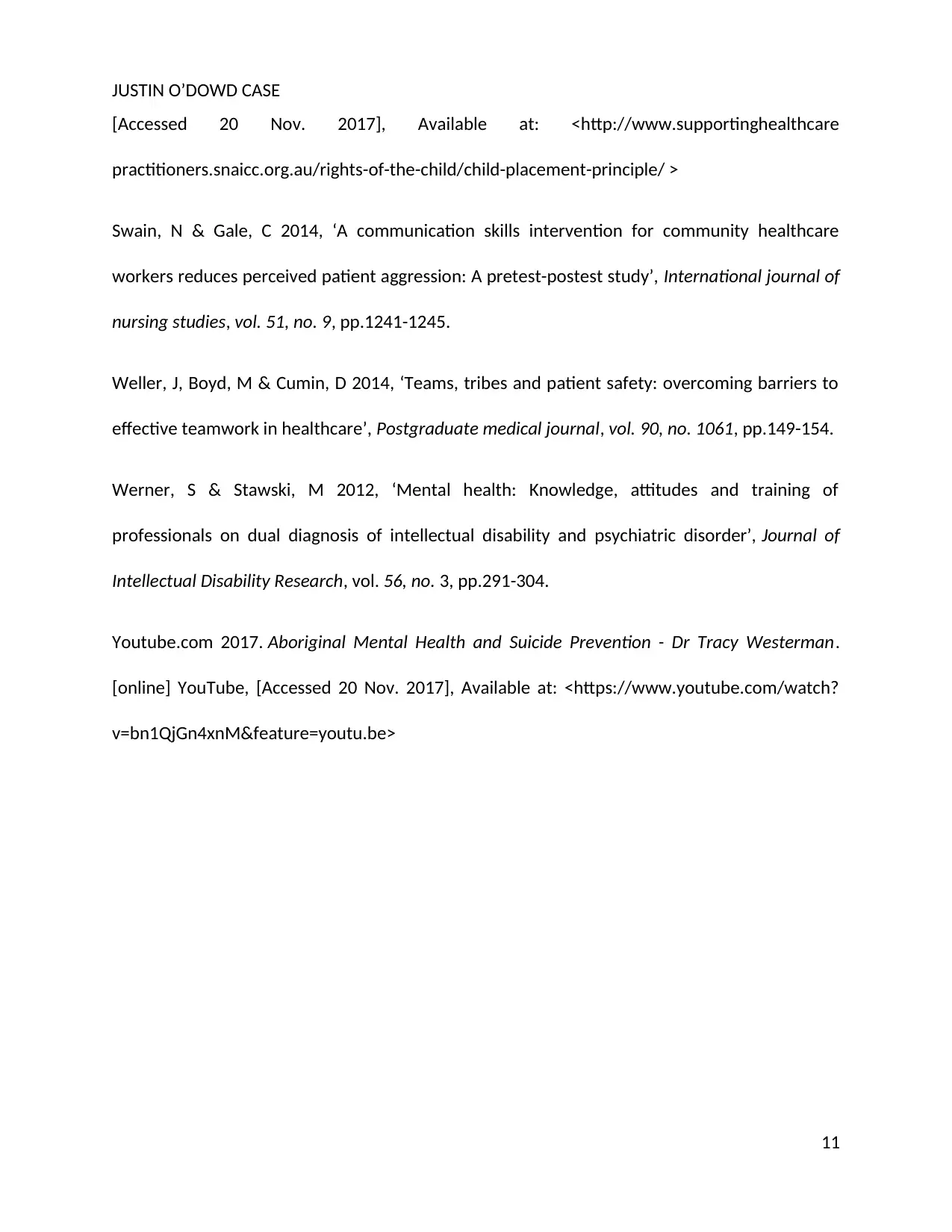
JUSTIN O’DOWD CASE
[Accessed 20 Nov. 2017], Available at: <http://www.supportinghealthcare
practitioners.snaicc.org.au/rights-of-the-child/child-placement-principle/ >
Swain, N & Gale, C 2014, ‘A communication skills intervention for community healthcare
workers reduces perceived patient aggression: A pretest-postest study’, International journal of
nursing studies, vol. 51, no. 9, pp.1241-1245.
Weller, J, Boyd, M & Cumin, D 2014, ‘Teams, tribes and patient safety: overcoming barriers to
effective teamwork in healthcare’, Postgraduate medical journal, vol. 90, no. 1061, pp.149-154.
Werner, S & Stawski, M 2012, ‘Mental health: Knowledge, attitudes and training of
professionals on dual diagnosis of intellectual disability and psychiatric disorder’, Journal of
Intellectual Disability Research, vol. 56, no. 3, pp.291-304.
Youtube.com 2017. Aboriginal Mental Health and Suicide Prevention - Dr Tracy Westerman.
[online] YouTube, [Accessed 20 Nov. 2017], Available at: <https://www.youtube.com/watch?
v=bn1QjGn4xnM&feature=youtu.be>
11
[Accessed 20 Nov. 2017], Available at: <http://www.supportinghealthcare
practitioners.snaicc.org.au/rights-of-the-child/child-placement-principle/ >
Swain, N & Gale, C 2014, ‘A communication skills intervention for community healthcare
workers reduces perceived patient aggression: A pretest-postest study’, International journal of
nursing studies, vol. 51, no. 9, pp.1241-1245.
Weller, J, Boyd, M & Cumin, D 2014, ‘Teams, tribes and patient safety: overcoming barriers to
effective teamwork in healthcare’, Postgraduate medical journal, vol. 90, no. 1061, pp.149-154.
Werner, S & Stawski, M 2012, ‘Mental health: Knowledge, attitudes and training of
professionals on dual diagnosis of intellectual disability and psychiatric disorder’, Journal of
Intellectual Disability Research, vol. 56, no. 3, pp.291-304.
Youtube.com 2017. Aboriginal Mental Health and Suicide Prevention - Dr Tracy Westerman.
[online] YouTube, [Accessed 20 Nov. 2017], Available at: <https://www.youtube.com/watch?
v=bn1QjGn4xnM&feature=youtu.be>
11
1 out of 12
Related Documents
Your All-in-One AI-Powered Toolkit for Academic Success.
+13062052269
info@desklib.com
Available 24*7 on WhatsApp / Email
![[object Object]](/_next/static/media/star-bottom.7253800d.svg)
Unlock your academic potential
© 2024 | Zucol Services PVT LTD | All rights reserved.





